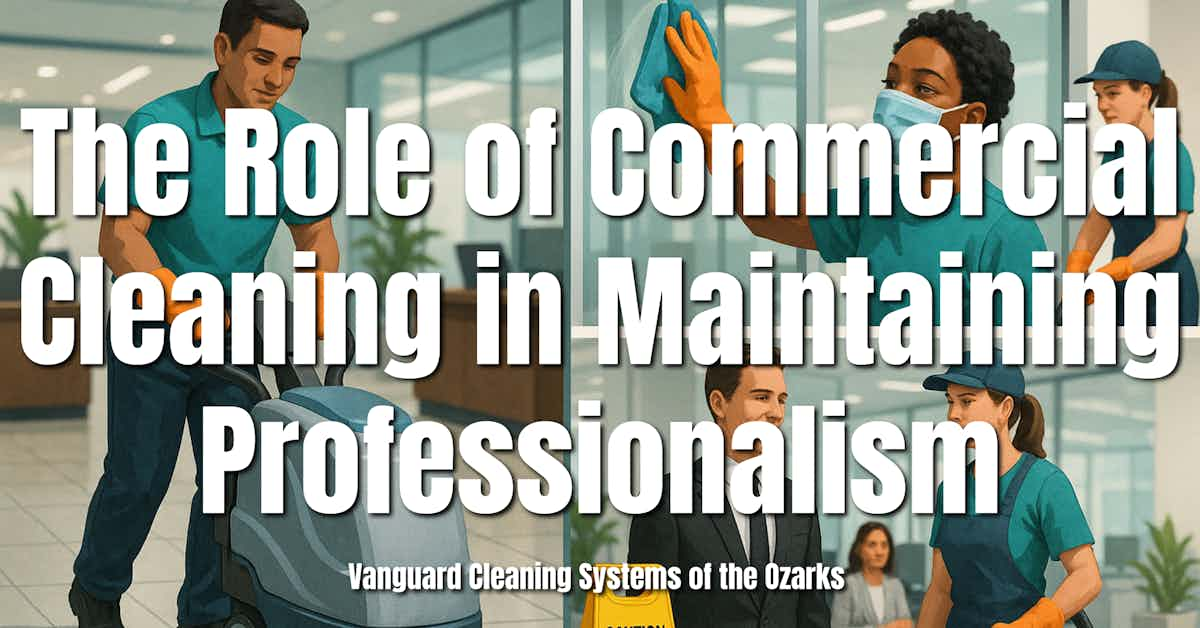A spotless facility isn't just clean—it’s your brand’s first impression, your team’s safeguard, and your silent partner in professionalism.

Why Clean Spaces Mean Serious Business
Cleanliness is often the first thing people notice—and the first thing they judge. Whether it’s a customer walking into a storefront or a potential client stepping into a boardroom, the state of your space speaks before you do. Professional cleaning plays a silent yet powerful role in shaping how your business is perceived. It impacts trust, safety, and the credibility of your brand. When done right, commercial cleaning goes beyond appearances—it becomes a cornerstone of operational excellence and organizational pride.
Cleanliness and First Impressions
Cleanliness sets the tone for how a business is perceived—before a word is spoken or a product is seen.
- First impressions form in seconds. A spotless lobby or restroom signals professionalism, while dirty floors or smudged windows suggest neglect.
- Customers associate clean spaces with safety and trust. In industries like healthcare, finance, and food service, poor sanitation immediately raises doubts.
- Visible upkeep builds confidence. Clean glass, polished floors, and fresh-smelling air communicate attention to detail and organizational discipline.
Consistent commercial cleaning reinforces your brand’s credibility. Whether it’s an office suite or a retail floor, daily cleaning routines help:
- Protect your business image
- Set expectations for service quality
- Convey respect for employees and visitors
A clean environment doesn’t just look good—it shows your business takes pride in every detail.
Health and Hygiene Standards
Clean environments are essential to employee wellness, customer safety, and regulatory compliance.
- Routine disinfection limits germ transmission. High-touch surfaces—like door handles, desks, and break room counters—harbor bacteria that contribute to workplace illness.
- Proper cleaning protocols reduce infection risks. In healthcare and food service environments, this directly impacts liability and public trust.
- Airborne contaminants are minimized by dusting, vacuuming, and using the right products. This helps control allergens, asthma triggers, and respiratory irritants.
When commercial cleaning is done professionally:
- Infection control outcomes improve
- Absenteeism rates drop due to healthier workspaces
- Regulatory violations become less likely
Standardized cleaning schedules ensure critical areas are serviced regularly. The result is not only a safer facility but a visible demonstration of your company’s commitment to health and professionalism.
Economic Efficiency and Operational Excellence
Professional cleaning isn't just about appearance—it’s a smart business strategy.
- Modern systems reduce waste. Automated dispensers, microfiber tools, and bucketless mopping minimize product overuse and lower supply costs.
- Labor costs are optimized. Centralized cleaning models improve task efficiency, allowing fewer employees to maintain larger areas with better results.
- Energy and water use drop. Upgraded equipment and controlled chemical dosing lead to lower utility bills and reduced environmental impact.
Businesses that invest in structured cleaning programs experience:
- Long-term cost savings
- Higher productivity from maintenance staff
- More consistent service quality
Professional cleaning workflows streamline operations. From shift planning to equipment maintenance, everything runs smoother—supporting both profitability and a polished brand image.
Worker Safety and Service Quality
Safe cleaners deliver better service. When staff are protected and properly trained, professionalism becomes the standard.
- Ergonomic tools prevent injury. Lightweight handles, swivel mops, and height-adjustable carts reduce strain on joints and backs.
- Chemical exposure is controlled. Clear labeling, PPE use, and safe product substitutions lower the risk of skin irritation, asthma, and long-term health issues.
- Training improves performance. Structured onboarding and refresher courses ensure every task—from restroom sanitization to floor care—is done correctly.
Supporting cleaning staff with the right tools and systems leads to:
- Fewer workplace injuries and sick days
- Higher morale and lower turnover
- Greater consistency in service delivery
When cleaners feel valued and safe, they take pride in their work. That pride is visible in every polished surface, spotless floor, and sanitized touchpoint—building a cleaner, more professional environment for everyone.
Brand Image and Organizational Dignity
Cleanliness reflects your values. It shows that your business takes pride not just in what it offers, but how it operates.
- Uniformed, well-trained cleaning staff signal professionalism. Their presence reinforces structure, discipline, and care behind the scenes.
- Defined cleaning protocols elevate standards. Schedules, checklists, and quality audits ensure consistency and accountability.
- Clean environments boost employee morale. Staff are more likely to respect and maintain tidy spaces when those spaces are consistently well-kept.
A professionally maintained facility sends a clear message:
- Your brand values order, detail, and reliability
- All roles—especially cleaning—are respected and essential
- Clients and employees are worth the investment in cleanliness
Professional cleaning isn't a background task—it’s a frontline expression of brand integrity. Clean spaces reinforce dignity at every level of the organization.
Innovation and Sustainability
Modern cleaning methods do more than clean—they drive efficiency and align with sustainable business goals.
- Automation enhances consistency. Robotic floor scrubbers and smart dispensers maintain high standards without relying on manual oversight.
- Microfiber technology reduces chemical use. With better absorption and fewer passes required, microfiber tools deliver superior results using less product.
- Smart dosing systems cut waste. Accurate chemical mixing prevents overuse, protects surfaces, and lowers environmental impact.
Sustainable cleaning practices lead to:
- Lower operational costs
- Compliance with environmental standards
- A stronger reputation among eco-conscious clients
By investing in innovation, businesses demonstrate leadership. Cleaners equipped with advanced tools work faster, safer, and more effectively—supporting a professional image while reducing the organization’s footprint.
Air Quality and Respiratory Protection
The products used in commercial cleaning directly affect indoor air quality—and by extension, everyone’s health and comfort.
- Spray disinfectants and harsh chemicals release volatile organic compounds (VOCs). These can trigger asthma, headaches, and irritation in both staff and visitors.
- Poor ventilation compounds the risk. In enclosed areas, airborne particles from cleaning agents linger longer and accumulate.
- Safer product alternatives protect workers. Switching to low-toxicity, fragrance-free, or non-aerosol options minimizes exposure without compromising hygiene.
Improved air quality results in:
- Fewer respiratory complaints from employees
- Better long-term health outcomes for cleaning staff
- A cleaner, more breathable environment for clients and guests
A professional cleaning strategy includes product selection, ventilation practices, and protective equipment. This attention to air safety isn’t just good hygiene—it’s a visible commitment to employee care and operational excellence.
Frequently Asked Questions
Why is commercial cleaning important for professionalism?
A clean environment reflects attention to detail, reliability, and care. It creates a strong first impression and reinforces your brand’s credibility.
How does professional cleaning impact employee health?
Regular cleaning reduces germs, allergens, and airborne irritants—leading to fewer sick days, improved air quality, and overall workplace wellness.
What are the benefits of using modern cleaning technology?
Automated tools and microfiber systems reduce waste, improve consistency, lower costs, and enhance both safety and cleaning performance.
Can cleaning affect a business’s reputation?
Yes. Customers and clients notice cleanliness immediately. A well-maintained space builds trust, while visible neglect can damage your image.
Is eco-friendly cleaning worth the investment?
Absolutely. Sustainable products and practices reduce environmental impact, improve indoor air quality, and appeal to environmentally conscious clients.
References
- Fedko, N., Malkina, L., & Shilo, D. (2023). Experience of implementing professional cleaning technologies in a modern medical organization. Meditsinskaya sestra. https://doi.org/10.29296/25879979-2023-06-05
- Selvaraj, S., & Harnett, D. (2018). An analysis of the quality and operational efficiency of the Crest Clean franchise. https://researcharchive.wintec.ac.nz/id/eprint/6285/
- Abrantes, M., & Cruz, S. (2014). Service interaction and dignity in cleaning work: how important is the organizational context?. Employee Relations, 36, 294-311. https://doi.org/10.1108/ER-06-2013-0064
- Lee, W., Lin, J., Bao, S., & Howard, N. (2021). Measuring risks for commercial cleaner safety: A scoping review. Proceedings of the Human Factors and Ergonomics Society Annual Meeting, 65, 1598 - 1599. https://doi.org/10.1177/1071181321651088
- Walker, B., Milek, D., Ryan, A., Bao, S., Lin, J., Lee, W., Goggins, R., & Rivera, C. (2020). Workload Issues among Commercial Cleaning Workers (Discussion Panel). Proceedings of the Human Factors and Ergonomics Society Annual Meeting, 64, 947 - 949. https://doi.org/10.1177/1071181320641226
- Bormann, R., Hägele, M., & Hampp, J. (2015). New brooms sweep clean - an autonomous robotic cleaning assistant for professional office cleaning. 2015 IEEE International Conference on Robotics and Automation (ICRA), 4470-4477. https://doi.org/10.1109/ICRA.2015.7139818
- Zock, J., Folletti, I., Olivieri, M., Sastre, J., Tarlo, S., Quirce, S., Blay, F., Raulf‐Heimsoth, M., Siracusa, A., Moscato, G., & Walusiak‐Skorupa, J. (2013). Asthma and exposure to cleaning products – a European Academy of Allergy and Clinical Immunology task force consensus statement. Allergy, 68, 1532 - 1545. https://doi.org/10.1111/all.12279
- Lipińska-Ojrzanowska, A., Wiszniewska, M., & Walusiak‐Skorupa, J. (2017). Work-related asthma among professional cleaning women. Archives of Environmental & Occupational Health, 72, 53 - 60. https://doi.org/10.1080/19338244.2016.1156046
Conclusion
Cleanliness is more than a maintenance task—it’s a visible and strategic expression of professionalism.
- It shapes first impressions and builds trust.
- It protects health, enhances safety, and supports daily operations.
- It reinforces brand values and shows respect for both workers and clients.
A professionally cleaned space reflects the quality of the business behind it. From the tools used to the people doing the work, every detail matters. Investing in commercial cleaning is investing in your company’s image, integrity, and long-term success.
Vanguard Cleaning Systems of the Ozarks' franchise-owned custodial service provider business cleans more than 8M sq. ft. weekly, maintaining an industry-topping 95+% of its customer base, year-over-year, and boasting more than 60 5-star Google reviews.
Need more capability from your vendor partners? --Let's talk.
In Oklahoma, dial 918-960-4450
In Arkansas, dial 479-717-2410
In Missouri, dial 417-812-9777

